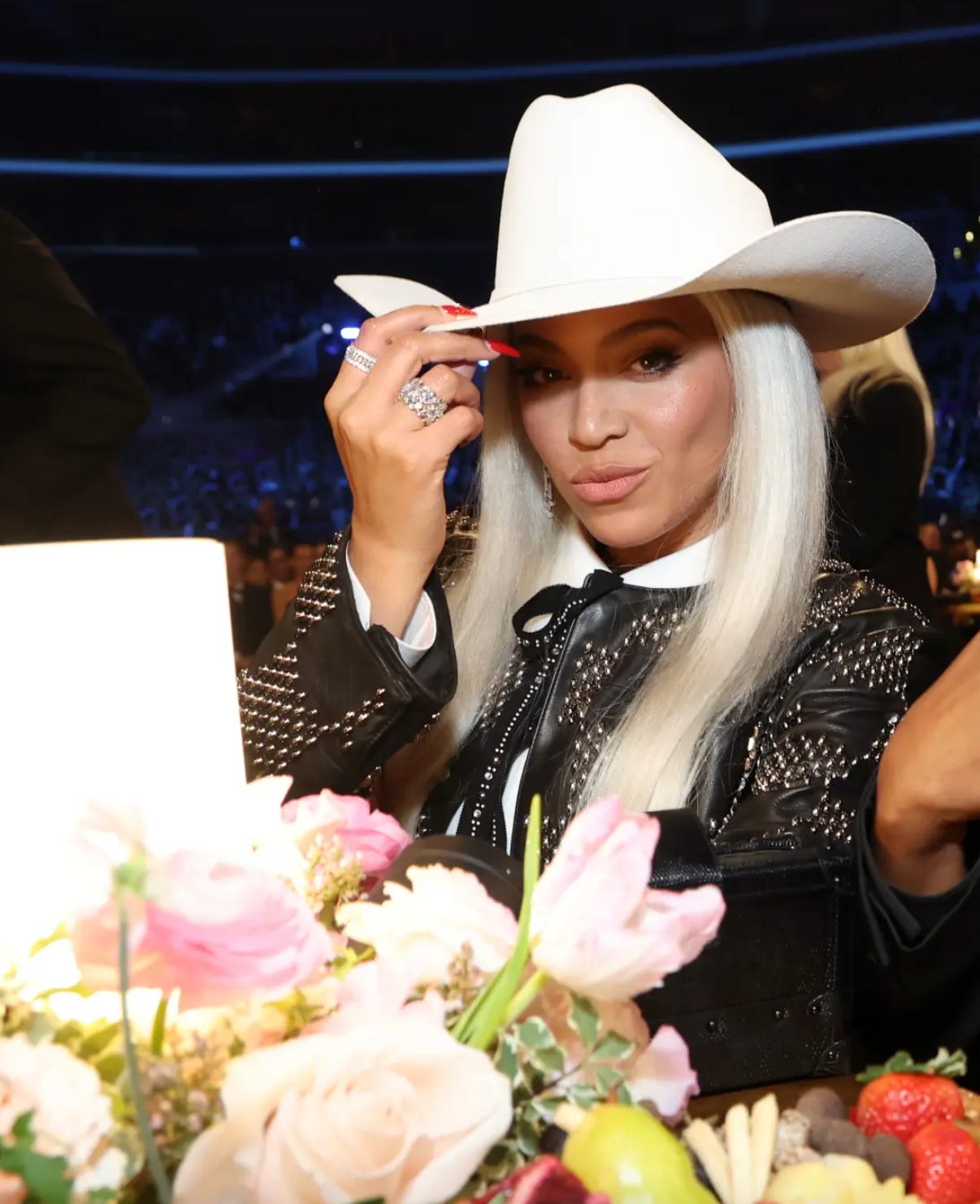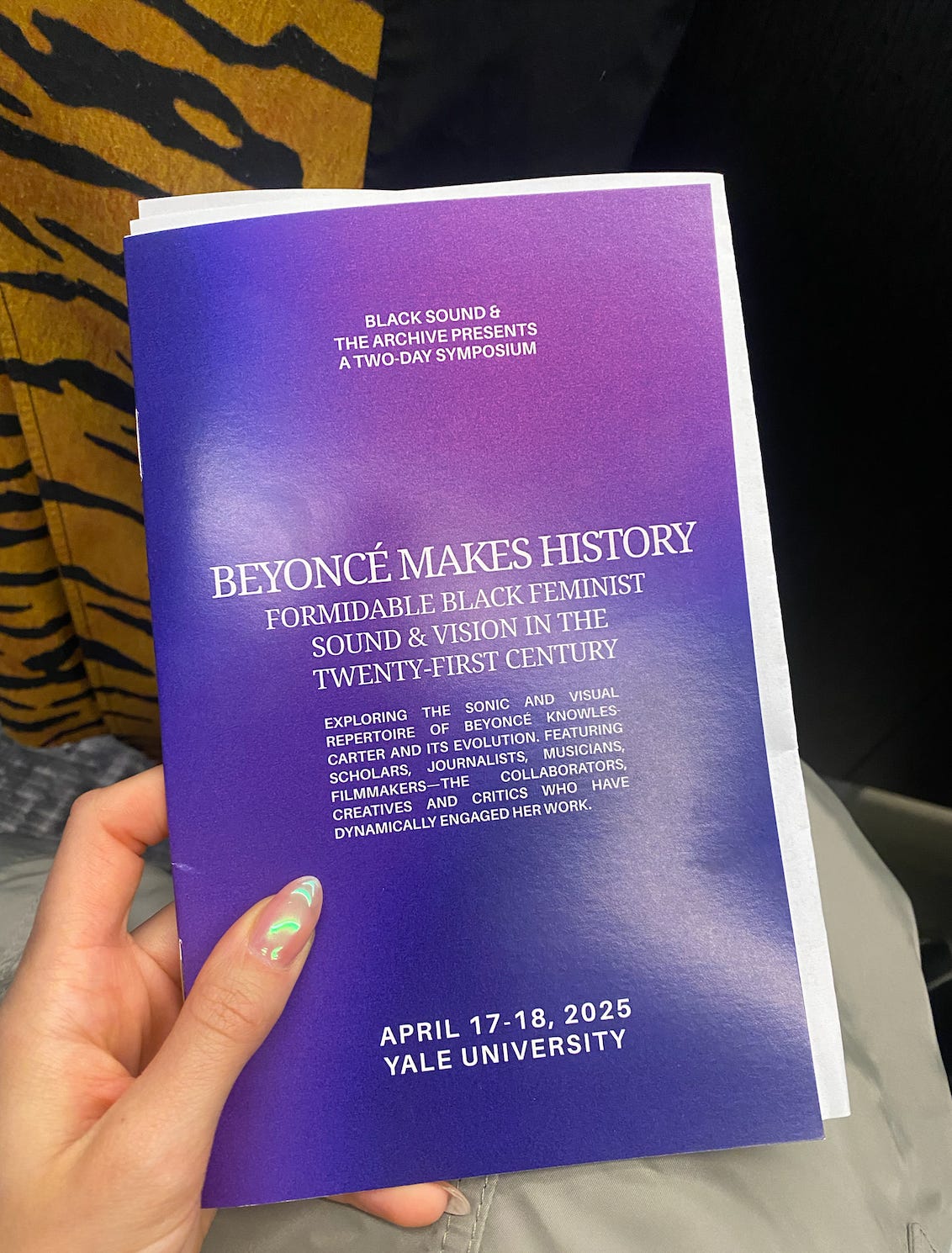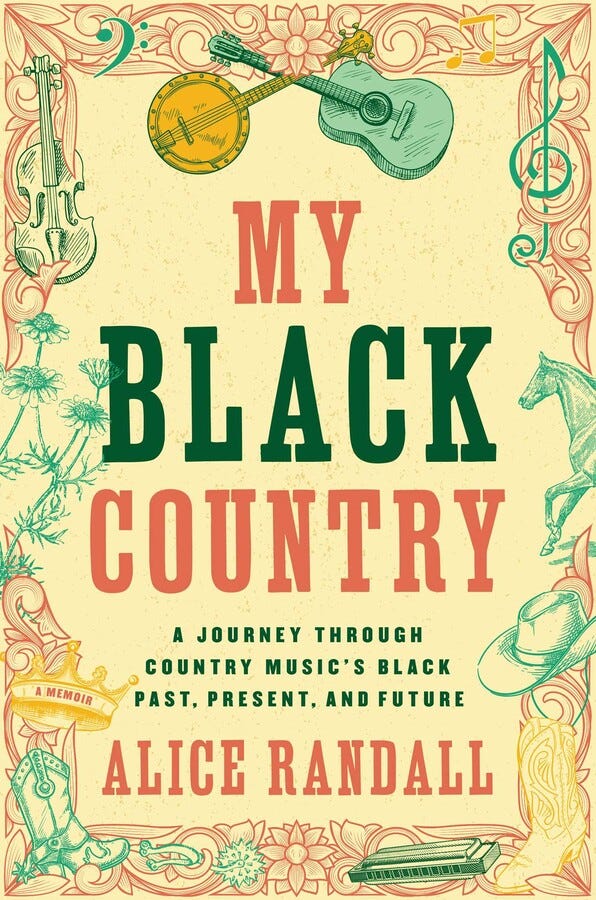Is It Freedom If I Can’t Feel It?
Untangling the threads of Cowboy Carter, Sinners and Met Gala Black Dandyism

First off, Happy Met Monday to all who celebrate! This year’s carpet looks are about to descend on our timelines once again, but this time with the Blackest theme ever, “Superfine: Tailoring Black Style.” Second, Sinners is the No. 1 movie in America for the third weekend in a row and well on its way to becoming a cult classic. Last and never least, Beyonce’s Cowboy Carter and the Rodeo Chitlin' Circuit Tour is starting to bring the hoedown to stadiums across America. There’s a whole lotta Black roots being discovered, explored and rewarded right now, some for the first time in a long time.
Like Beyoncé’s consequential, country-fried album last year, the horror-thriller of Sinners overflows with symbolism and history and does it all while relishing the roots of Black American music. And although a lot of the point of both works is to challenge the audience to think beyond boxes like genre, for the sake of this post, let’s say that for Bey, those roots are country. For director Ryan Coogler, the roots are blues.
Reading through the liner notes of Cowboy Carter and Sinners, it’s no surprise that studio session superhero Raphael Saadiq was involved in both projects. Even though the tones are different, the smoky haunting of “Ameriican Requiem” conjures spirits the same way “I Lied To You” does. Rhiannon Giddens, the Pulitzer Prize-winning singer, banjo player and Black folk music archivist also consulted and played on both projects. Her banjo lick on “Texas Hold ‘Em” welcomed fans into the Cowboy Carter journey last spring.

Aesthetically, Bey’s wardrobe morphed from titanium and glitter for her RENAISSANCE era into fitted suits, turquoise bolos and 10-gallon hats for Cowboy Carter. And whether its a deep crimson wide brim hat and a pinstripe three-piece or a newsboy cap and a houndstooth suit, the fine tailoring Smoke and Stack Moore sport in Sinners is meant to signal how working for the gangsters of Chicago have raised their sense of style, identity and dignity. They’re outlaws for sure. Maybe even tyrants. But for Bey and the boys, the confidence of rebellion is dressed up with the flair of Black dandyism. It seeps through the cloth.

As I’ve been watching and loving it all, I’ve also been wondering: How do these roots connect? And where do they tangle?
Bey will be our point A.
Back in April, I was invited to attend and participate in a symposium at Yale University all about Beyonce. As a music critic and a Hot Sauce-carrying member of the BeyHive, I was obviously intrigued and accepted the invitation from the symposium’s organizer, Professor Daphne A. Brooks. Over the two days, conversations ranged from a retrospect of the Lemonade film to Mrs. Carter’s contradictions as a Black billionaire to the expansiveness and depth of her references to her Blond ambition to her countryness to her cuntyness to whether or not her feminism is real in practice. It was a lot. It was everything.
I was asked to recite a lil piece of criticism/fantasy I’d written a couple years ago around some songs off the RENAISSANCE album a.k.a. ACT I in her still-unfurling sonic trilogy. It was cute to perform my work for an audience of intellects, but I’m honest and realistic enough to acknowledge I got so much more than I gave to this event. I soaked up all the knowledge I could from the greats: Dr. Daphne Lamothe, Dr. Joan Morgan, Kevin Quashie, Danyel Smith and more. One conversation that’s seared into my memory from the day was between Black country artist Rissi Palmer and songwriter and author Alice Randall. As a Black woman who spent more than 40 years as a songwriter in the Nashville scene, Randall spilled just how whitewashed she’s had to make her work over the years in order to get play in a racist industry. She also expertly broke down four key truths about the storytelling in country music:
God is real.
Life is hard.
Family, the road and strong whiskey help with the hardship.
The past is better than the present.
Now, that last truth – the past is better than the present – will hit your ears very differently as a country listener depending on if you believe America needs to be made “great again” or if you know your ancestors trace back to the Door of No Return in West Africa.
Looking at the visuals and costuming of the 32-stop Cowboy Carter tour so far, the LA nights have been emblazoned with spaghetti Western motifs and red white and blue to a level of glorious camp that 1. tickles me but 2. makes me genuinely wonder what version of the past Bey’s referencing. Are her country aesthetics a subversion of the union? Is she reclaiming or ridiculing the colors? How does Alice Randall’s last truth play into the tour’s visual thesis?
Early in the setlist, Bey belts out a rendition of “The Star-Spangled Banner” (accompanied by audio of Jimi Hendrix 1969 Woodstock performance of it) and then transitions into the snarl of her 2016 track “Freedom.” It’s literal political performance. Besides a feat of vocal acrobatics, the switch-up juxtaposes the freedom the national anthem sells with the lack of freedom she and many other Black Americans feel on the daily. It’s a tangle because this juxtaposition seems to never get fully resolved in the show and even though it sounds and looks incredible, there’s a tension to it that rings hollow.
Despite the name, this tour isn’t making too many stops in America’s Chitlin’ Circuit this summer. (Although how fire would it be if she made a surprise appearance at the Howard Theater or Lincoln Theater during her July 4th show in Maryland?) I haven’t attended the tour yet so I’m genuinely wondering if, as a concert-goer, a sense of liberty is felt at the end of the night. Is there a flood of patriotism leaving the stadiums or just the adrenaline rush of a great show, fire fit pics and leftover Klarna payments? Either way, when the crowd checks their phones on the way out, the push notifications of the Trump administration coming at DEI practices, public media, and Black historical archives are still rolling in, a reminder that even the freedom we’ve known in the present is slowly being chiseled away.
From the stadium to the cinemas. Sinners spoilers ahead. But fr, it's been weeks, please get to a damn theater, already!
There’s one scene in Sinners where Delta Slim, the seen-it-all, oldhead bluesman – Delroy Lindo better get some awards for this role – sums up the epitome of blues music in action. With a swig of corn liquor, he shares a memory of getting arrested for vagrancy with his friend, a charge that was a way-too-common Jim Crow copout in the early 1900s. While they were in the jailhouse, they started playing music. They somehow entertained the cops enough to be set free. The very next day, white men accuse his friend of raping a white woman,“cut off his manhood” and hang him in the middle of a train station. Delta breaks out in a humming, thumping blues melody imbued with the soul-tearing heartbreak of the story.
The source material is pain, imagination and the ingenuity to turn nothing into something. It’s this push and pull of lighter-than-air euphoric freedom replaced by head-bashing reminders of slavery and danger that surges through the blues. Having freedom dangled just above your eye line all the time like that is the swirl of hope, wonder, fear and anxiety that emotionally fuels the whole movie.
Later, after all the biting starts, vampire zaddy Remmick tries to sell the characters in the juke joint on vampirism as a form of freedom and an escape from the racism of the 1930s they’d never be able to experience otherwise. The only catch is, the price of that freedom is a soulless, nocturnal immortality. The irony is that soul is what you need most to sing the blues. They’d never feel whole again. Where’s the freedom in that?
Onto the carpet steps.
This year is arguably the Blackest theme ever from the Metropolitan Museum of Art's Costume Institute. At least, I’m arguing it is. This is the first time in the Met’s history that all the hosts of the night are Black men: Colman Domingo, Lewis Hamilton, A$AP Rocky, Pharrell Williams. LeBron James is also an honorary chair. Of course, the spirit of the late, great style editor Andre Leon Talley will be all up and through the evening.

In the U.S., Black dandyism became a fashion statement in the 18th Century – the timeframe where Sinners is set – as a way to claim agency, professionalism and a sense of freedom. Some describe Black dandyism as a “quiet rebellion” because Black men were adopting European tailoring to, as Vogue put it, “assert dignity in a world that denied it.” But freedom by whose definition? And at what cost?
Like Smoke and Stack in Sinners in their fits, the tailored suit is a signal of wealth that was (and is) withheld from the majority of Black Americans. Even though they’re from the Delta and returning home, the twins coming through in those suits signal that they’re on a different level now. They mean business. To make it to the point of wearing clothing like this makes them an exception as Black men. The suits are like armor that only a few can afford to protect themselves with. There’s a level of white assimilation to early dandyism that undercuts the freedom it aspires. Whiffs of respectability politics on the wind have easily gotten stuck in those dandy threads before.
From the early 1900s til now, Black dandyism has expanded way beyond top hats, fitted blazers and Harlem Renaissance salons reserved for the Talented Tenth. It’s loud, colorful, flamboyant, exuberant. The dichotomy of dandyism and the 90s s(w)ag of the hip-hop generation — which was once decidedly undignified by high-fashion types back in the day — has flourished in people like Young Thug, Lil Uzi Vert, Tyler, The Creator and more. This evolution has prioritized infusion rather than division.
Just like with the Cowboy Carter tour and Sinners, I’m going to be vigilant for real signs of freedom and expression heading into tonight’s Met Gala; Freedom from checked boxes of conformity, from white-adjacent, soulless assimilation and from half-hearted rebellion in the name of turning a look.
In the between time 👔:
Here are my “ones to watch”* for at this year’s Met Gala carpet:
(*I don’t know if these people all have an invite, but this is what I wanna see!)
Thugger Thugger. A recreation or exaggerated flip of his 2016 Jeffery album cover on the carpet six months after being released from jail?! A want and a need.
Doechii, who took her Thom Browne agenda all the way to the Grammys earlier this year. If you haven’t yet, check my piece on Doechii’s style and star power here.
June Ambrose, who said in an interview recently that she’s never had a seat at the Met Gala despite heavily guiding hip-hop into its suit-and-tie era via styling Jay-Z, Will Smith, Missy Elliott and many others. Give June her things.







